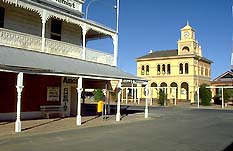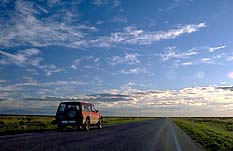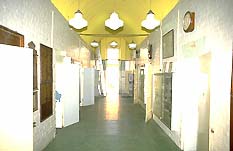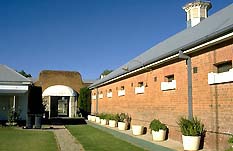
|
| Japps Pharmacy and the
Post Office |
Hay (including Oxley)
Substantial and historic service centre in the heart of
the Riverina.
Hay is an important pastoral town of the Riverina area.
Located 728 km west of Sydney via the Great and Mid Western
Highways it is situated alongside the Murrumbidgee River at
the junction of the Sturt, Cobb and Mid Western Highways,
halfway between Sydney and Adelaide. 94 m above sea-level
and with a population of 2817 it is surrounded by completely
flat, open, treeless saltbush plains. Indeed the road from
Hay to Maude is as flat as western Queensland or the
Nullarbor Plain.
Joseph Furphy, who lived in Hay while bullock carting
about the region in the 1870s, set much of his famous novel
Such is Life (1903) within the district. This descriptive
passage from the novel provides some insight into the
terrain about Hay: 'the dark boundary of the scrub country
disappears northward in the glassy haze, and in front,
southward, the level black-soil plains of Riverina proper
mark a straight sky-line, broken here and there by a
monumental clump or pine-ridge. And away beyond the horizon,
southward still, the geodesic curve carries that monotony
across the zone of salt-bush, myall and swamp box; across
the Lachlan and Murrumbidgee and on to the Victorian
border.'

|
| The road between Hay and
Balranald |
This flatness makes the tree-lined streets of Hay (very
attractive in autumn) ideal for bicycles, which are a common
sight around town. Hay is also the centre of an area which
is known as the best medium merino wool region in Australia.
Some of the local studs are famous in pastoral circles -
Mungadal, Uardry and Cedar Grove. Mungadal lies west of town
adjacent the Sturt Highway. The Uardry property supplied the
image of the ram for the former Australian shilling.
The introduction of an irrigation scheme in the 1950s
expanded the range of production. Today Hay has rice and
feed crops. Other sources of local income include the market
gardens, grains, legumes, cattle and fat lambs.
The Ngiyambaa or Nari-nari Aborigines inhabited the area
prior to white settlement. Charles Sturt explored the Murray
and Murrumbidgee Rivers in 1829-30 passing by the future
townsite in his whaleboat. There is a monument in Sturt Park
(Lachlan St) to commemorate his journey.
Squatters followed in Sturt's wake. The 'Illiliwa' run,
established in the 1840s, contained the land on which
northern Hay would later be built. The neighbouring station
was owned by John Tooth. Hay South would develop on land
that was part of the 'Eli-Elwah' run of William Guise and
the Mungadingadal (now Mungadal) run was occupied by the
Lang Brothers. On their property was an important river
crossing. At such locations stockmen, headed south to the
Victorian markets, or north to pasture, would rest
themselves and their cattle before fording the river.
Consequently, the locale was initially known to Europeans as
Lang's Crossing.
River-steamer captain Francis Cadell (see entry on
Jerilderie) built a store at the crossing in 1858. When
American Henry Leonard set up a punt service then built a
hotel, a local squatter pulled a section of it down with a
bullock team. It was Leonard's appeal to the government for
assistance that led to the opening of the Murrumbidgee Punt
Hotel and the establishment of the township, which was
gazetted in 1859. The initial title of 'Waradgery' was
abandoned and the town was named after local parliamentarian
John Hay.
The first courthouse was erected in 1860 on the site of
the present post office. Cobb & Co, made Hay the
headquarters of their Victoria and Riverina operations from
1862 to 1896. The arrival of the company's coaches, feed
wagons, 20 drivers, 103 horses, plus cooks and ostlers was
greeted with a brass band. They set up a coach factory at
the corner of Lachlan and Simpson streets in 1877.
Hay was also a major river port for the Lachlan squatting
district. It was declared a municipality in 1872.
The years between 1865 and 1900 saw the population swell
from 300 to 3000. The town's importance was apparent when it
was chosen as the site of the procathedral and base of
operations for the bishop when the Goulburn diocese was
divided in 1884 to form the Riverina diocese.
In World War II Hay was used as a POW and internment
centre. The process got under way in 1940 with the
construction of three internment camps. The first arrivals,
unfortunately, were 2036 Jewish internees from Nazi Germany
and Austria - mostly professionals who had simply fled for
their lives - along with 451 German and Italian POWs. They
were transported from England on-board the 'Dunera,' hence
the moniker 'the Dunera Boys,' which was applied, in
particular to the Jewish refugees.
Conditions on the ship were appalling. The passengers
were not allowed to leave the ship during stopovers and were
rarely permitted on deck and, when they did, the British
crew scattered bottles in their path to deter them.
Conditions were also unsanitary.
In circumstances reminiscent of events in recent years,
the refugees (and POWs) were transported to Hay via train
and then placed in the camps behind barbed wire. They
remained active, holding physical education courses and
concerts, teaching the children and printing their own
money. All of these internees were moved to
Tatura in May 1941.
A ferw weeks later, about 2000 Italian POWs arrived from
the battlefields of Egypt. They worked at farming practices,
making the camps largely self-sufficient. Only one escaped
and he spent six months in Melbourne before being
recaptured.
In December of 1941 Japanese internees were conveyed to
the camp from
Cowra. Unfortunately, a number of them were merely
Australians from Broome who were descended from Japanese
stock; some of whom had never been to Japan.
The repatriation of the POWs was carried out in 1946 and
the camp was dismantled and all building materials auctioned
in 1947.
There was a reunion of these internees in 1990 and a
memorial has been placed on Showground Rd, opposite the Hay
Town Bush Fire Headquarters (past the showground). More
recently an interpretive centre on the subject has been set
up at the old railway station.
Ironically, after the war, Italian migrants arrived in
Hay and established market gardens.
Things to see:
![[Top of page]](smlArrow.gif)
Visitors Information Centre
The visitor's information centre at 407 Moppett St, near the
corner with Lachlan St (the Cobb Highway), has pamphlets
which will take you on heritage walks about the town. They
also have hot showers, toilets, baby-change facilities and
electronic tourist information, all available 24 hours a
day. Nearby, in the coach pavilion, is 'Sunbeam', a Cobb &
Co. coach. Built locally in 1886 it ran on the Deniliquin to
Wilcannia line and was used in the Mad Dog Morgan film in
1975. On the other side of Moppett St, on its original site,
is an ornate, cast-iron fountain given to the town in 1883
by its mayor, John Witcombe.
Historic Buildings
Heading south along Lachlan St, between Moppett and Bank Sts
are several public and commercial buildings which make a
fine contribution to the main street. The shire office
(1877), with its stout verandah posts, was originally the
town's second courthouse. The lands office (1896), also
notable for its verandah posts, as well as for the railing
and windows, was one of the first such buildings to be
designed for the outback climate. The post office (1881),
with its multiple arches and beautiful cast-iron railing
along the second storey balcony was designed by James
Barnet. It is situated on the site of the town's first
courthouse and lockup. The clock tower was added in 1901.
The Westpac Bank building, erected in 1877, originally
housed the A.J.S. Bank. Opposite the post office is Japp's
Pharmacy, again with attractive turned timber posts and some
highly ornate cast-iron lacework along the upstairs balcony.
Take the right into Bank St. About halfway along the
block is St Andrew's Presbyterian Church. The oldest known
building in Hay it went up in 1872; the vestry and
schoolroom were built in 1892. Take the first right into
Pine St and, on the corner with Orson St, is the old
Presentation Convent. Built in 1900 it has a beautiful front
door of painted glass, French tiles on the roof and
Wunderlich panelling inside.
Back at Moppett St is the substantial and stately brick
courthouse. The town's fourth it was built in 1892 with some
alterations made in 1920. The original slate roof has been
replaced with tiles and the interior panelling replaced with
Queensland maple but the whole has been carefully restored.
There are stained-glass windows, marble fireplaces and
furniture dating back to 1818. The verandah is of solid
brick with arches. On the other side of Pine St is the old
Masonic Lodge (1878).
North along Pine St, across Moppett, is St Paul's
Anglican Church (1885), the procathedral for the diocese of
the Riverina. Opposite is Hay Park with children's
playground, aviary, duck pond, barbecue and picnic
facilities and beautiful Morton Bay fig trees.
Continue north to Murray St. On the southern corner is
the old Terminus Hotel. Built before 1880 it served railway
passengers from 1882 until it was delicensed in 1940. Over
the road is the elaborate Victorian bonded brick railway
station (1882) with ornate ridges hanging from the roof.
Both these and the platform verandah columns are of cast
iron. The central section is two storeys high, the
surrounding area has been landscaped and the whole has been
returned to its original heritage colours. All up it is an
impressive and generally intact landmark.
Railway cottages built for porters, drivers and tappers
are located at 429-439 Murray St. Also dating from 1882 they
are considered good surviving examples of low-cost
government housing in the late Victorian period. The station
master's residence, like the station itself, was built by
Charles Hardy in 1882. The last train ran in 1983.

|
| Inside the cell area of
the Hay Gaol |
Hay Gaol Museum
Turn back along Pine St and take the second left into Church
St. Over Piper St, to your left, is Hay Gaol Museum. The
gaol complex was built in 1879 to replace an earlier prison
(probably dating from 1871) and has had an interesting
history. Despite architecturally inappropriate additions and
alterations it remains a good example of a Victorian
country-town gaol. It was mostly used for short-term
offenders from the district. Closed in 1915 it became a
maternity hospital from 1921. It resumed operations as a
prison again in 1930, doubling as a lock-up for those
waiting to have their sanity assessed. Those found sane were
released, those found insane were sent to a mental hospital.
In World War II the gaol was used in connection with the
POW camps. After the last POWs were repatriated in 1947 it
was largely abandoned. Then, in 1961, it was made into an
experimental centre for incorrigible girls. Ringleaders from
the Parramatta detention centre were sent to Hay for three
months of constant surveillance, supervision and extremely
tight disciplinary, dress and behavioural codes. This phase
of the building's existence ended in 1974. Hay Gaol now
operates as a museum and cultural centre where artifacts of
local history are stored and displayed. It is open from 9-5
daily (03 6993 1003).

|
| Hay Gaol
|
Shear Outback, Australian Shearer's Hall of Fame
Located on the Sturt Highway at Hay and called Shear Outback
this new tourism initiative, opened in 2002, describes
itself as providing "visitors with a contemporary and
innovative museum experience. Showcasing the stories,
artefacts, technology and culture of the Australian shearing
industry, the facility comprises an iconic 'purpose built'
interpretative centre and an historic woolshed relocated
from the banks of the Murray River."
Shear Outback is a complete experience of shearing and
sheep. There are five separate aspects of the experience
starting with The Shearer's Hall of Fame which honours the
achievements of shearers and the sheep industry. There are
also an interactive experience, a Murray Downs shearing shed
and an extensive historic archive. The Museum is open 9.00
a.m. - 5.00 p.m. daily. The attractions include shearing
demonstrations at 10.30 a.m., 1.00 p.m., and 3.30 p.m.
although these times can vary depending on weather
conditions and visitor numbers. Admission to the museum
costs: Adults $15, Concession $10, Children (under 12) $8,
Family $35. Group bookings are available upon application.
Hay Prisoner of War and Internment Camp Interpretive
Centre
Situated within two restored train carriages, at the old
railway station in Murray St, the display relates to the
internment camps in Hay. The process got under way in 1940
with the construction of three internment camps. The first
arrivals, unfortunately, were 2036 Jewish internees from
Nazi Germany and Austria - mostly professionals who had
simply fled for their lives - along with 451 German and
Italian POWs. They were transported from England on-board
the 'Dunera,' hence the moniker 'the Dunera Boys,' which was
applied, in particular to the Jewish refugees.
Conditions on the ship were appalling. The passengers
were not allowed to leave the ship during stopovers and were
rarely permitted on deck and, when they did, the British
crew scattered bottles in their path to deter them.
Conditions were also unsanitary.
In circumstances reminiscent of events in recent years,
the refugees (and POWs) were transported to Hay via train
and then placed in the camps behind barbed wire. They
remained active, holding physical education courses and
concerts, teaching the children and printing their own
money. All of these internees were moved to
Tatura in May 1941.
A ferw weeks later, about 2000 Italian POWs arrived from
the battlefields of Egypt. They worked at farming practices,
making the camps largely self-sufficient. Only one escaped
and he spent six months in Melbourne before being
recaptured.
In December of 1941 Japanese internees were conveyed to
the camp from
Cowra. Unfortunately, a number of them were merely
Australians from Broome who were descended from Japanese
stock; some of whom had never been to Japan.
The repatriation of the POWs was carried out in 1946 and
the camp was dismantled and all building materials auctioned
in 1947. There was a reunion of internees in 1990. The
Centre is open weekdays from 9.00 a.m. to 5.00 p.m. and
entry is currently $2, tel: (02) 6993 4045.
Bishop's Lodge
If you head east at the roundabout at the southern end of
town, along Moama St (the Sturt Highway), you will find, to
your left, Bishop's Lodge, the former residence of the first
Anglican bishop of the Riverina, Sydney Linton, who
supervised its construction in 1888. Somewhat unusual
architecturally this Victorian villa was built of corrugated
iron and timber, with sawdust for insulation. It has been
restored and the exterior paintwork returned to its original
colours. Surrounded by a magnificent nineteenth-century
garden it is currently open for inspection from 2-4 every
Saturday for tours and at other times by appointment (02
6993 1861). The Lodge is also available as an exhibition and
conference centre. Just up the road, to the right, is
Ruberto's Winery.
Water Activities
There are several large sandy beaches along the river for
swimming, boating, canoeing, waterskiing and fishing for
golden perch, silver bream, Murray cod, redfin, catfish,
Murray crayfish and yabbies. Sandy Point Beach at the end of
Water St has a boat ramp. Soap Works Beach, 1 km down the
road to Maude (Cadell St), has a picnic area and is a safe
swimming spot. 13 km along this road is Hay Weir which has
picnic and free electric barbecue facilities. Just
downstream is a fishing spot known as Fisherman's Palteau.
Sturt's Marked Tree
4 km east of Hay , on the Mid Western Highway, is Sturt's
Marked Tree, a box tree famous for the markings which
Charles Sturt carved upon it in 1829. There is a nature
track which follows the river around Hay and just out of
town is Hay Wetlands Nature Reserve which is home to an
array of waterbirds, best seen either at dawn or dusk,
especially in springtime when the birds nest.
One Tree Hotel
The One Tree Hotel is 38 km north on land that was
originally a pastoral holding. It was built in 1862 as
Finch's Inn and served as a staging post on the Cobb & Co.
run between Hay and Wilcannia until that service ended in
1914. Here the passengers would disembark for lunch and a
rest while the horse team was changed. William Clark bought
the hotel off Alexander Finch and he leased the huge
government tank nearby which watered up to 12,000 sheep at a
time. Horse and bullock teams of up to a thousand in number
were watered at the charge of a penny per head. The inn was
purchased by the McQuade family in the 1880s who still own
it. Although the original structure burned down in 1901 the
insurance claim stated that recompense could only be made if
the building was rebuilt exactly as it had been so the
current hotel is a replica. The license lapsed in the 1940s
when it became a private residence. It is currently derelict
but worth a look. One Tree was proclaimed a village in 1885
though it never grew and the old building is a lone sentinel
on the plains today.
One Tree is halfway to Booligal, made famous by 'Banjo'
Paterson's poem 'Hay, Hell and Booligal'. It is thought that
the 'Hell' refers to Hells Gate, a property which lies
between Hay and Balranald.

Broadwalk
Business Brokers
Broadwalk Business
Brokers specialise in General Businesses for Sale, Caravan Parks for
Sale, Motels for Sale, Management Rights & Resorts for Sale, Farms for
Sale, Hotels for sale,Commercial & Industrial Properties for Sale.
Phone:
1300 136 559
Email:
enquiries@broadwalkbusinessbrokers.com.au
AUSTRALIAN BUSINESSES FOR SALE
COFFS HARBOUR BUSINESS BROKERS
BROADWALK BUSINESS BROKERS
GOLD COAST BUSINESSES FOR SALE
BRISBANE BUSINESSES FOR SALE
SYDNEY BUSINESSES FOR SALE
CARAVAN PARKS FOR SALE
BUSINESSES FOR SALE
MOTELS
FOR SALE
HOTELS
FOR SALE
Disclaimer
We advise prospective purchasers that we take no
responsibility for the accuracy of any information in the business
provided by vendors or their professional advisers and that they should
make their own enquiries as to the accuracy of this information,
including obtaining independent legal and/or accounting advice
Hay

